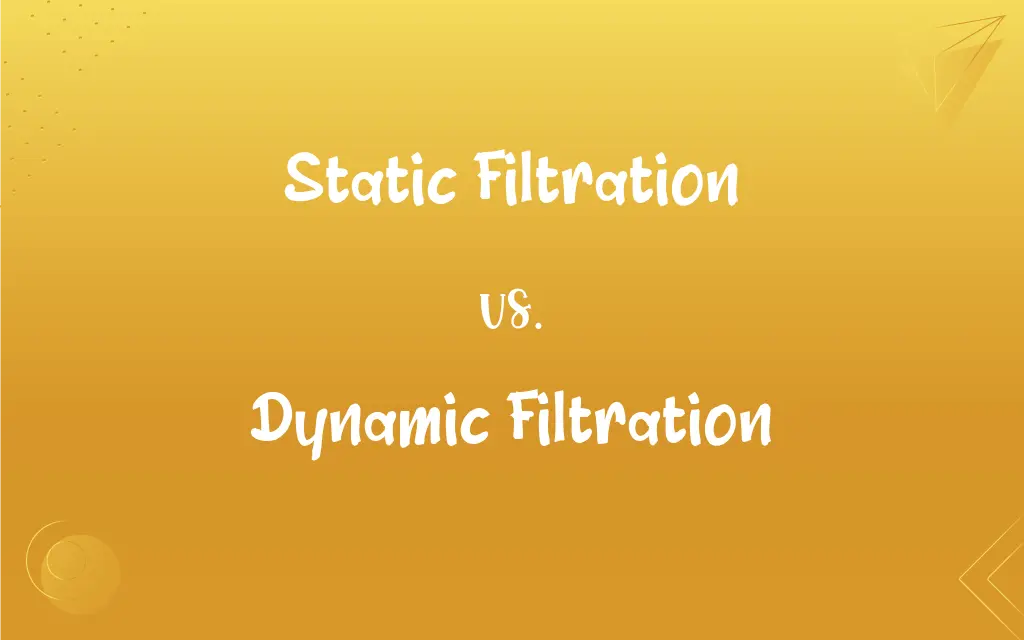Static Filtration vs. Dynamic Filtration: What's the Difference?
Edited by Aimie Carlson || By Janet White || Published on August 22, 2024
Static filtration involves filtering a fluid without movement, relying on gravity or pressure, while dynamic filtration uses a moving mechanism or fluid flow to enhance filtration efficiency.

Key Differences
Static filtration operates under a constant set of conditions, typically utilizing gravity or a pressure differential to drive the separation of solids from liquids. This process is characterized by a lack of movement in the filtration medium or the fluid being filtered, aside from the initial flow through the filter. Dynamic filtration, on the other hand, involves active movement either within the filtration system, such as a rotating drum or vibrating screen, or by inducing a flow that continuously moves particles across the filter surface, preventing clog formation.
In static filtration, the buildup of a filter cake on the filter medium can slow down or even stop the process, necessitating periodic cleaning or replacement of the filter. Dynamic filtration systems are designed to continuously or periodically remove the buildup, maintaining a consistent flow rate and efficiency over time. This makes dynamic filtration more suitable for processes requiring continuous operation or handling high solid content.
Static filtration is often simpler and more cost-effective for small-scale operations or applications with low solid loads, due to its straightforward design and minimal moving parts. Dynamic filtration systems, with their moving parts and often more complex designs, are better suited for industrial applications where high throughput and continuous operation are critical.
The choice between static and dynamic filtration largely depends on the specific requirements of the process, including the nature of the fluid and solids, the required purity of the filtrate, and operational considerations such as energy consumption and maintenance needs. While static filtration is adequate for many applications, dynamic filtration offers enhanced capabilities for challenging filtration tasks.
Static filtration systems are typically employed in applications like water purification, wine making, and small-scale chemical processing, where the filtration loads are manageable and the processes can tolerate intermittent operation. Dynamic filtration finds its place in industries such as mining, wastewater treatment, and chemical manufacturing, where large volumes and continuous processing are the norm.
ADVERTISEMENT
Comparison Chart
Mechanism
Uses gravity or pressure, no moving parts
Involves moving parts or fluid to enhance filtration
Operation
Continuous until filter cake forms, then requires intervention
Designed for continuous operation with mechanisms to prevent clogging
Suitability
Small-scale operations, low solid content
Industrial applications, high throughput
Maintenance
Requires periodic cleaning due to filter cake buildup
Often has self-cleaning mechanisms to maintain efficiency
Typical Applications
Water purification, wine making
Mining, wastewater treatment, chemical manufacturing
ADVERTISEMENT
Static Filtration and Dynamic Filtration Definitions
Static Filtration
Characterized by the absence of moving parts in the filtration system.
Static filtration systems are often preferred for their simplicity.
Dynamic Filtration
Involves active movement to enhance filtration efficiency.
The plant's dynamic filtration system used a rotating drum to separate solids.
Static Filtration
A process where fluid is passed through a filter by gravity or pressure.
The laboratory used static filtration to separate the precipitate.
Dynamic Filtration
Suitable for continuous and high-volume processes.
Dynamic filtration was essential for the continuous operation of the wastewater treatment plant.
Static Filtration
Often requires manual intervention to clear blockages.
The technician had to regularly check the static filtration setup for clogs.
Dynamic Filtration
Often features self-cleaning systems.
The dynamic filtration unit's self-cleaning feature minimized downtime.
Static Filtration
Prone to filter cake formation, which can halt the process.
In static filtration, the buildup of solids necessitated frequent filter changes.
Dynamic Filtration
Requires energy for moving parts, but offers higher throughput.
Despite its energy use, the dynamic filtration system handled large volumes efficiently.
Static Filtration
Suitable for applications with lower solid loads.
Static filtration was chosen for the small-scale wine production.
Dynamic Filtration
Designed to prevent the buildup of solids on the filter.
Dynamic filtration mechanisms include backwashing to maintain flow rates.
FAQs
What is static filtration?
Static filtration is a process where fluids are filtered through a medium using gravity or pressure without any moving components in the system.
What defines dynamic filtration?
Dynamic filtration involves the use of moving parts or fluid dynamics to enhance the filtration process and prevent clogging.
What are the advantages of dynamic filtration?
Dynamic filtration offers continuous operation, higher throughput, and often includes self-cleaning mechanisms, making it suitable for industrial applications.
When is static filtration preferred?
Static filtration is preferred for simpler, smaller-scale applications with lower solid content, where periodic maintenance is manageable.
Can static filtration handle high solid loads?
Static filtration can struggle with high solid loads due to filter cake formation, which can block the filter medium.
How does dynamic filtration maintain efficiency?
Dynamic filtration systems often have self-cleaning features, such as backwashing or mechanical scraping, to continuously remove solids buildup.
How do static and dynamic filtration differ in mechanism?
Static filtration relies on gravity or pressure alone, while dynamic filtration uses movement, such as rotating drums or fluid flow, to improve efficiency.
Are dynamic filtration systems energy-intensive?
Dynamic filtration systems can be more energy-intensive due to their moving parts, but they offer greater efficiency and throughput.
How does filter cake affect static filtration?
Filter cake formation in static filtration can reduce flow rates and efficiency, requiring manual intervention to clear the filter medium.
What maintenance does static filtration require?
Static filtration systems need periodic cleaning or filter replacement to remove filter cake and maintain flow rates.
Which industries commonly use static filtration?
Industries such as winemaking, small-scale chemical processing, and some types of water treatment often use static filtration.
What are the long-term costs associated with dynamic filtration?
Long-term costs for dynamic filtration include energy consumption, maintenance of moving parts, and potential replacement of components, balanced by the system's increased efficiency and throughput.
Where is dynamic filtration typically employed?
Dynamic filtration is commonly used in mining, wastewater treatment, and large-scale chemical manufacturing due to its continuous operation capability.
Can dynamic filtration handle various fluid viscosities?
Dynamic filtration can handle a range of fluid viscosities, with adjustments to the system's moving parts or flow rates to maintain efficiency.
Is static filtration suitable for potable water treatment?
Static filtration can be used in potable water treatment, especially in smaller or less complex systems.
What is the impact of dynamic filtration on product quality?
Dynamic filtration can enhance product quality by ensuring consistent removal of contaminants and maintaining a steady flow rate.
How do operators manage static filtration systems?
Operators of static filtration systems monitor for signs of clogging or reduced flow rates and perform maintenance such as cleaning or replacing filters as needed.
What design considerations are important for dynamic filtration systems?
Design considerations for dynamic filtration systems include the choice of moving mechanisms, energy efficiency, and ease of maintenance.
Can static filtration be automated?
While inherently simpler, static filtration systems can incorporate automated elements for monitoring and maintenance alerts.
How do dynamic filtration systems prevent clogging?
Dynamic filtration systems use mechanisms like rotation, vibration, or backwashing to continuously remove solids and prevent clogging.
About Author
Written by
Janet WhiteJanet White has been an esteemed writer and blogger for Difference Wiki. Holding a Master's degree in Science and Medical Journalism from the prestigious Boston University, she has consistently demonstrated her expertise and passion for her field. When she's not immersed in her work, Janet relishes her time exercising, delving into a good book, and cherishing moments with friends and family.
Edited by
Aimie CarlsonAimie Carlson, holding a master's degree in English literature, is a fervent English language enthusiast. She lends her writing talents to Difference Wiki, a prominent website that specializes in comparisons, offering readers insightful analyses that both captivate and inform.






































































